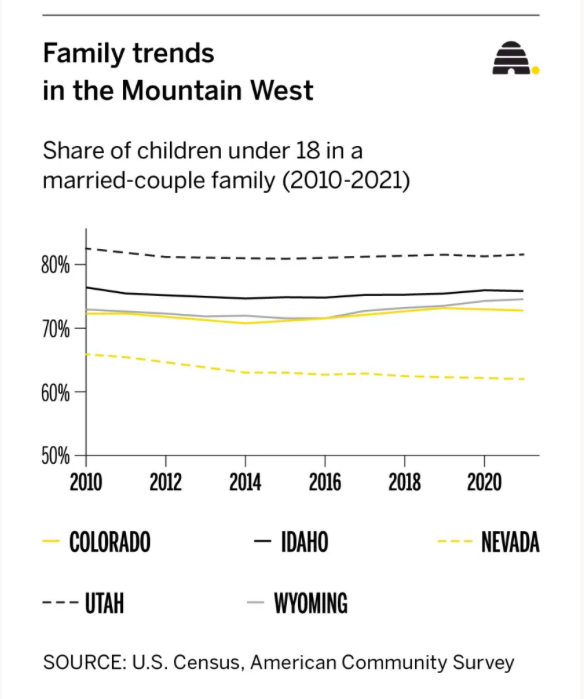Highlights
- The strength of “the Utah way” can be attributed, in part, to the state’s unique civic, religious and political endowments. But Utah’s success is also attributable to the strength & stability of its families. Post This
- The “Utah family miracle” matters because social science tells us that one of the strongest predictors of a state’s economic success is strong families. Post This
- With over 4 in 5 children being raised in a married-couple family, Utah remains the national leader in giving children the advantage and promise of a stable home environment. Post This
Utah ranks at the top of many rankings of state performance across America. But perhaps the Beehive State is best known for its top rankings on the economic front. The “Utah economic miracle” — marked by exceptional economic growth, a favorable business climate and high rates of economic mobility — has garnered attention across the nation and helps explain why Utah’s economy ranks No. 1 among all 50 states, according to U.S. News & World Report.
While Utah’s sky-high economic performance has gotten a lot of attention, the state has also gotten high marks when it comes to happiness. Numerous surveys of happiness put Utah in the top 10 states for emotional well-being. In fact, Gallup ranked Utah No. 1 for well-being in a recent study focusing on the emotional health, life evaluation, healthy behaviors, physical health and work environments of men and women across the nation. These rankings suggest that Utah has pioneered a unique path combining prosperity and happiness in the 21st century.
The strength of “the Utah way” can be attributed, in part, to the state’s unique civic, religious and political endowments, including unusually high levels of social capital and low levels of government regulation. But Utah’s material and emotional success is also attributable to the strength and stability of its families.
No state in the union has as many men, women and children in married households as the Beehive State. In 2021, 55% of adults in Utah (ages 18-55) were married and 82% of its children were living in married-couple families. This compares to a national average of 45% of adults married and 75% of kids living in married families. Utah’s regional family strength is visible in this graphic, which shows how the state compares to other Mountain West states.

What could be called the “Utah family miracle” matters because social science tells us that one of the strongest predictors of a state’s economic success is strong families.
Recent research by economists Joseph Price at Brigham Young University and Robert Lerman at the Urban Institute, as well as Brad Wilcox at the University of Virginia, indicates, for instance, that one of the top predictors of economic performance across the states is the share of married parents. In their words, “the percentage of parents who are married in a given state is typically a stronger predictor of the state’s economic mobility, child poverty and median family income than are the education level, racial makeup and age composition of its population.”
Likewise, Harvard economist Raj Chetty and his colleagues found that the Salt Lake City metro area has some of the highest rates of economic mobility for poor children across America. One key reason for that finding is that the region has more two-parent families than other metro areas across the nation.
Poor children in the Salt Lake area, for instance, are much more likely to be raised in a two-parent family and to be surrounded by peers from two-parent families than poor kids in other metro areas. In fact, in their research, Chetty and his colleagues found that “the strongest and most robust predictor (of children’s economic mobility) is the fraction of children (in the community) with single parents.”
These are but two empirical indications that Utah’s economic miracle depends in no small part on the strength and stability of its families.
Likewise, although we do not have any direct empirical evidence that Utah’s high marks for happiness are derived from the strength of its families, lots of indirect evidence points in that direction. Studies tell us that men and women who are married are more likely to be flourishing psychologically in general, and happy, in particular.
In fact, research indicates the most powerful predictor of adult happiness in America is the quality of men’s and women’s marriages. The “estimated contribution of marital happiness is far greater than the estimated contribution of (other) kinds of satisfaction, including satisfaction with work,” noted sociologists Norval Glenn and Charles Weaver. Research like this suggests that the emotional health of Utahns is linked to the strength of families.
Troubling Trends
Utah has long been known for its strong families and its high marriage and fertility rates — what we are calling here the “Utah family miracle.” But recent trends suggest that as the state has grown, its status as a family outlier may be starting to converge with national norms.
Much of Utah’s population growth is being driven by new residents; a sign of the state’s economic health and cultural vitality, no doubt, but also a sign that suggests the state is not immune to a broader national tendency to delay marriage and postpone or defer childbearing.
In fact, marriage and fertility rates are falling across the state — save in one exceptional county — in ways that suggest Utah’s distinctive family culture is in danger of looking more like its peers in the Mountain West.
Still, the Beehive State’s remarkably high rate of family stability remains strong, suggesting that Utah children will continue to benefit from the advantage of growing up in a two-parent household.
Fertility Within Utah
Within Utah, the highest population growth has been in Utah County, which has been growing at a rate of more than 2% a year for the past decade, and surging even higher post-COVID-19. That’s due to a mix of natural population growth and in-migration; the number of children under 18 in Utah County grew by nearly 50,000 from 2011 to 2021, even as the birthrate in the county dipped. It’s a sign that the county is attracting young families as well as making it affordable to have children.
While the overall birthrate has fallen over the past decade, Utah County remains an outlier compared to the rest of the state, with roughly 12.5 births among every 100 married women in 2021.
Salt Lake County, despite having its overall population grow 15% over the past decade, saw its under-18 share of the population fall from 29.1% to 26.8%. To put that in concrete terms, while Salt Lake County has added more than 173,000 residents since 2010, only 23,800 of those new residents are children under 18.
Similarly, the rural counties in the northern half of the state have seen marked population growth but a decline in the number of births, suggesting a high percentage of in-migration, while the population in the southern counties has remained largely stagnant, with the notable exception of Washington County.
Utah’s traditionally high rates of fertility are falling to national levels in Salt Lake County and more rural areas.
Family structure within Utah
With over 4 in 5 children being raised in a married-couple family, Utah remains the national leader in giving children the advantage and promise of a stable home environment. The rate is almost unfathomably high in Utah County, where nearly 9 in 10 children are raised in a two-parent married household; nationally, about two-thirds of households with children are headed by married parents. Indeed, no mid- or large-sized county in America has as many kids being raised in married-parent families as Utah County.
Nearly half — 47% — of all households in Utah County have children under 18 in the home, outpacing the rest of the state (38.5%) and far outstripping the national average (28.4 %).
The benefits and social stability of a culture in which more than 90% of children grow up in a two-parent household cannot be understated, and they are a large part of what has driven the Utah family miracle for so many years. Recently, Salt Lake County has also seen a slight uptick in the share of children being raised by married parents as nonmarital childbearing continues to fall in that county.
Perhaps most notable for the future, however, is that Utah has not been immune to the national trend of declining marriage rates. Unlike Wyoming and Idaho, which both saw a slight increase in marriage rates during the strong economy of the late 2010s, Utah’s marriage rate has ticked steadily down before plunging in the wake of COVID-19.
In 2012, 82 out of every 1,000 never-married males over age 15 and 95 out of every 1,000 females in Utah would tie the knot. In 2021, those rates were down to 63 males and 77 females getting married per 1,000; the decline predated the shock of the pandemic. The decline in the marriage rate was strongest in Salt Lake and southern counties and more muted in Utah County.
In sum, in looking at demographic trends in the state, the historically strong picture for family formation in Utah shows some clouds on the horizon. On the one hand, Utah’s distinctively high commitment to marriage and childbearing is softening at this moment. But at the same time, the state continues to lead the nation in affording children the gift of married parents and maintains its position as a pioneer in making it possible to start and raise a family.
Brad Wilcox, a professor of sociology at the University of Virginia and director of the National Marriage Project, is the Future of Freedom Fellow at the Institute for Family Studies and a visiting scholar at the Sutherland Institute. Patrick T. Brown is a fellow at the Ethics and Public Policy Center and a former staff member for Congress’ Joint Economic Committee under then-chairman Sen. Mike Lee. Jenet Erickson is an associate professor at Brigham Young University and a research fellow of the Wheatley Institute and Institute for Family Studies.
Editor's Note: This piece, which appeared first at The Deseret News, was adapted from The Utah Family Miracle: Five Policy Ideas to Keep Utah Families Strong and Stable, a new joint report from Sutherland Institute and the Institute for Family Studies.










